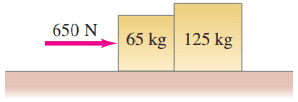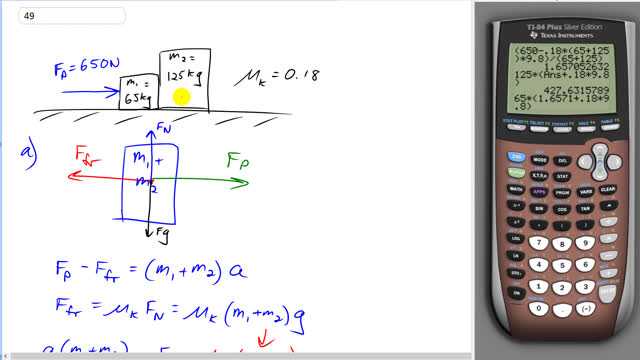
Two crates, of mass 65 kg and 125 kg, are in contact and at rest on a horizontal surface (Fig. 4–57). A 650-N force is exerted on the 65-kg crate. If the coefficient of kinetic friction is 0.18, calculate
- the acceleration of the system, and
- the force that each crate exerts on the other.
- Repeat with the crates reversed.


In order to watch this solution you need to have a subscription.
This is Giancoli Answers with Mr. Dychko. These two crates are on a surface with a coefficient of kinetic friction of 0.18 there's a 650 Newton force applied by a person, FP we’ll call it, and the first mass is 65 kilograms and the mass 2 is 125 kilograms. And the first question is to figure out what will the acceleration of the system be. And so, we'll consider it as a system, as one thing, consider it as one box of a total mass m1 plus m2. And then we can talk about the force applied by the person on that combined system and the single friction force of this combined system and its normal force in the force of gravity. And from that figure out the acceleration. So, we know that the force to the crate applied by the person minus the force to the left of friction equals the net force. And so, that makes it the mass times acceleration. And the mass is given by m1 plus m2 in this case. And we also know something about the friction force and we can make a substitution into here then and then we'll solve for a. So, the friction force is the coefficient of kinetic friction times by the normal force. And in this case the normal force equals gravity down because there's no vertical acceleration. And gravity down is going to be the total mass times g. So, here is the friction force that will substitute into here on the next line. So, I also switch the sides around. So, we have the acceleration on the left since that's the unknown. And I've written muK, m1 plus m2 times g in place of force friction here. And then we'll divide both sides by this m1 plus m2 to isolate the unknown a. And so, acceleration is the applied force minus coefficient of kinetic friction times the total mass times g divided by the total mass. So, 650 newtons minus 0.18 times 65 plus 125 kilograms times 9.8 and then divided by the total mass. That gives about 1.7 meters per second squared is the acceleration. And then in part B we have to find the force that one box applies on the other and we have to do it only once because those two forces are Newton's third law pairs, there's a force on block 2 due to block 1 and there's a force on block 1 due to block 2. And we have to do this calculation only once because those two forces will have equal magnitudes. So, we're considering block 2 and the force to the right on block 2 due to block 1 minus the force of friction on block 2 equals the net force. And so, it is mass times acceleration, and in this case we're just considering block 2 so, mass is just m2 times its acceleration. We already figured out its acceleration, so, that's one of the knowns here and we're gonna solve for F21 force on block 2 due to block 1 we'll move is friction term to the right side, so, it's added to both sides, and then substitute it for it, it's a coefficient of kinetic friction times mass 2 times g. This is the normal force on block 2 normal force equals to the weight. And... So, here I just said with algebra that the force on block 1 due to block 2 is the same as the force on block 2 due to block 1. Strictly speaking, I suppose I should have a negative sign in there but, you know, we know what we're talking about. So, this equals mass 2 times acceleration plus coefficient of kinetic friction times g. I just factored out the m2 common factor there from both those terms. And then we have 125 kilograms times 1.6571 meter per second squared acceleration that we figured out in part A, plus 0.18 times 9.8. And we get about 430 newtons with two significant figures for the force applied on block 2 due to block 1. OK. So, in part C we switch the blocks around. So, we have the heavier one first. So, m2 is now on the left side and m1 is on the right side. And then we'll figure out everything again. Now, we don't have to repeat part A, the system is exactly the same, we can still think of it as one big box of mass, m1 plus m2, and nothing will change. Now, however, when we calculate the force on block 1 due to block 2 or the force on the right hand block due to the left hand block, we will get a different answer this time because given the same acceleration this right hand block is now much less massive, it's only 65 kilograms. Whereas before it was 125 kilograms and so, given that it's going to have the same acceleration because it's still the same total mass system and the same applied force to that system to get the same acceleration with less mass, there's going to be a less force on it and so, now let's calculate that force. So, here's the free body diagram and the force on block 1 due to block 2 is to the right and the force of friction on block one is to the left from the force up, gravity down normal force is equals gravity because there's no vertical acceleration. And here's Newton's second law, the net force to the force to the right minus force to the left equals the mass times acceleration, m1 in this case. And force of friction also is a coefficient of kinetic friction times the normal force. And the normal force is the weight of gravity. And we'll rewrite this equation with the friction term on the right hand side just as we did before. So, we have mass 1 times acceleration plus the friction, and then substitute muK m1 g in place of friction to get this here. And in factor out the m1 just to be slick and tidy. And then we get 65 kilograms times 1.6571 meters per second squared, same acceleration as before, plus 0.18 times 9.8 meters per second squared. And we end up with an answer of 222 and that should have two significant figures, so, we will write two 20 newtons.